The Anaheim Ducks‘ 2020-21 season has finally–and mercifully–come to an end, and the Ducks find themselves at the bottom of the pile. Second to bottom of the pile, if you want to get extremely specific. Of course, with the conclusion of the season comes an overview of how the players fared during said season. My colleague Eddy Jones and I decided to split up the grades by position for length and clarity sake. We also set a games played requirement of 10, so you won’t see Simon Benoit here, even though he played well in the six games he appeared in.
In terms of the grading scale, you can check out Eddy’s piece on the forwards here and why each player received the grade that they did. I like to think I’m a little bit forgiving with my grades than Eddy is, though!
Cam Fowler
2019-20 Season: 9 goals (G), 20 assists (A), 29 points (P) in 59 games played (GP)
2020-21 Season: 5 G, 18 A, 23 P in 56 GP
Analysis: Don’t let the baby face fool you. Fowler is now one of the elder statesmen on the Ducks’ blue line, having been in the NHL for over a decade now. During his rookie season, Fowler learned from one of the best defensemen to ever play in the NHL in Scott Niedermayer. The former Duck opened up his home to the then 18-year-old, who needed somewhere to live in Southern California after being drafted by the Ducks. Fowler is now instilling some of that knowledge on the younger generation.
For as much as the now 29-year-old has been criticized for his inconsistencies over the last 10 seasons (along with his polarizing contract), he has been a constant on the Ducks’ blue line. There is the possibility that he was thrown into the water just a bit too soon—he hasn’t registered a point total higher than 40 since his rookie season. But, he has rebounded from the disastrous 2018-19 campaign and while his stats might look similar on the surface level, his underlying numbers have improved greatly.
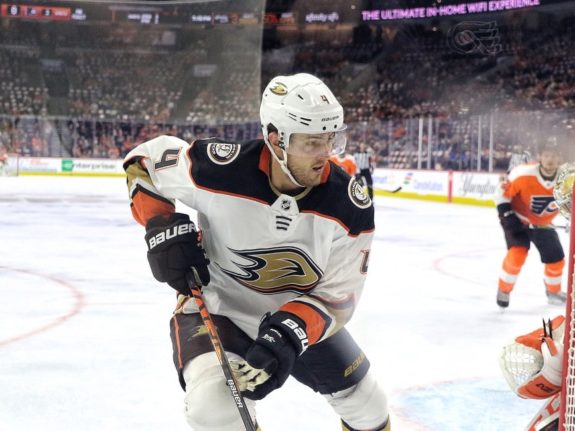
Because of the extended absences of Hampus Lindholm and Josh Manson this season, Fowler took on a lot more responsibility than the team likely foresaw going into the year. He was the only player on the team to play in all 56 games this season and an off-night was a rare sight to see for Fowler in 2020-21.
Next season should see the Ducks’ defensive core back to full health, which means that Fowler should have less of a workload.
Grade: B
Hampus Lindholm
2019-20 Season: 2 G, 20 A, 22 P in 55 GP
2020-21 Season: 2 G, 4 A , 6 P in 18 GP
Analysis: After being relatively injury-free over the course of seven seasons, the injury bug finally got Lindholm’s number. The Swede appeared in just 18 games this season, a definite career-low total for his entire career.
Lindholm’s absence was apparent throughout the season, as his impact was something that could not be shouldered by even all six of the defenders who laced up the skates every night for the Ducks. Even in his limited appearances, Lindholm was the ever consistent stay-at-home defender who cemented the Ducks’ defense over the past several seasons.
Lindholm will have one year remaining on his contract going into next season. You have to think that Murray will at least take some calls on his most valuable defenseman—yes, he is still the most valuable, even more than Jamie Drysdale.
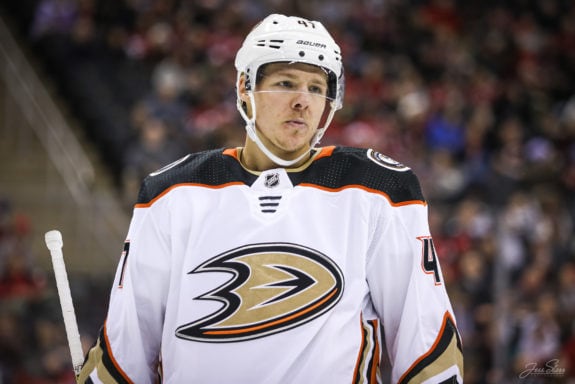
The Ducks appear very far away still from another extended postseason run and it would be worth a kick of the can to at least get something out of Lindholm instead of him departing for nothing next summer. Even waiting as long as until next season’s trade deadline would greatly reduce Lindholm’s value as he would become strictly a rental acquisition for most teams.
Grade: C
Josh Manson
2019-20 Season: 1 G, 8 A, 9 P in 50 GP
2020-21 Season: 1 G, 6 A, 7 P in 23 GP
Analysis: Manson’s season was wrought with injury and though he performed poorly when he was actually in the lineup, it seems a bit unfair to give him worse than a ‘C’ grade.
The 29-year-old is now a full-fledged veteran, having played in over 400 games at the NHL level. He would likely have been paired with Fowler had it not been for previously mentioned injury troubles. Manson’s Corsi and Fenwick numbers for this season are pretty ugly and his numbers on the surface aren’t much better.
He did, however, essentially match his points total from last season in about half the amount of games for what it’s worth, and he did that while holding a dZS% of just under 60 percent. This offseason will do Manson well as he will have the opportunity to get back to full health.
Grade: C
Kevin Shattenkirk
2019-20 Season: 8 G, 26 A, 34 A in 70 GP
2020-21 Season: 2 G, 13 A, 15 P in 55 GP
Analysis: Shattenkirk’s initial season with the Ducks could not have been much worse. The d-man registered the worst numbers of his career and looked completely out of his element. Sure, he had his moments, but he never really figured it out for a consistent stretch during the 2020-21 season. In fact, his performance was so underwhelming that it’s possible that he might have played himself out of being included on the Ducks’ protected list for the Seattle Expansion Draft.
For Shattenkirk’s first season of the three-year contract he signed this past offseason to be his only season with the Ducks would not be a surprise. He was brought in to be a catalyst for a middling power play. He did quite the opposite.
Many will be quick to point out that he tied for the team in power-play assists. That total was four. That’s not exactly a sparkling contribution, especially given that the team finished dead last when it came to power-play conversion. Their power-play percentage (PP%) was a putrid 8.94%. This assessment of Shattenkirk’s performance this past season might seem fairly harsh to someone on the outside looking in, but that gives you an idea of the performance expected out of the 32-year-old.
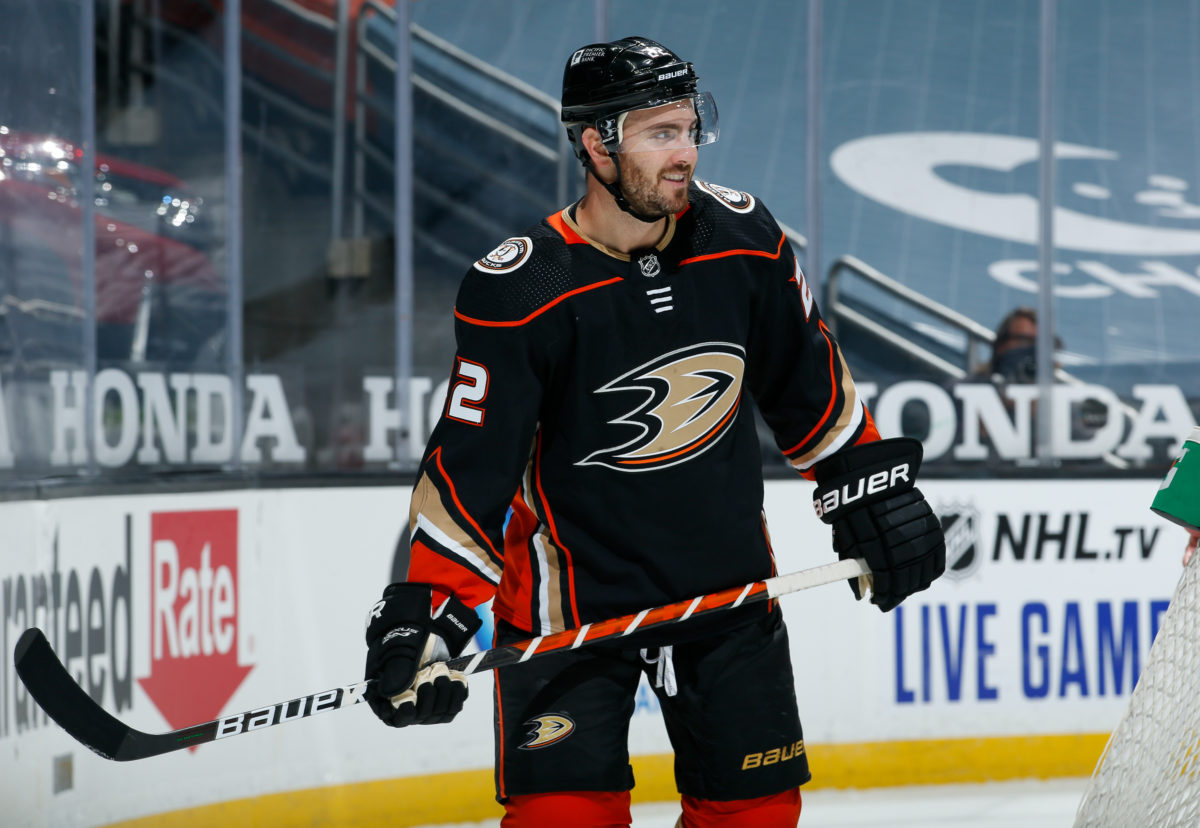
He was excellent in a sheltered role on an outstanding Tampa Bay Lightning team last season but has looked more like the player who underperformed with the New York Rangers over the duration of two seasons in 2017-18 and 2018-19 during his time with the Ducks this far. His advanced stats are a bit misleading as well as his sparkling Corsi and Fenwick numbers are due more to playing alongside Fowler as opposed to brilliant individual performance.
It’s plausible that Shattenkirk is just not capable of being “the guy” anymore. In his exit interview, he did say that he would be undergoing arthroscopic surgery to clear out a calcium deposit in his knee, which forced him to miss the season finale. Perhaps that had been hampering him for most of the season, but we’ll never truly know. There’s nothing that can really be done now besides either hoping for improvement next season or that the Kraken select him in the Expansion Draft.
Grade: F
Haydn Fleury
2019-20 Season: 4 G, 10 A, 14 P in 45 GP
2020-21 Season: 2 G, 1 A, 3 P in 12 GP for Anaheim
Analysis: Fleury only played 12 games for the Ducks after being acquired at the trade deadline for Jani Hakanpaa, but he made a good impression and should fill a role on the Ducks’ blue line next season. He likely won’t be in the Top-4 when everyone is healthy, but his being your No. 5 defenseman gives the Ducks the defensive depth they haven’t had for several seasons.
Fleury’s stats might not catch the eye at face value, but he is aggressive when it comes to joining the breakout and knows when to pick his spots. He’s already an upgrade over Hutton, Larsson and Hakanpaa and will turn 25 this summer. He’ll be a restricted free agent next year.
Grade: B
Jamie Drysdale
2020-21 Season: 3 G, 5 A, 8 P in 24 GP
Analysis: Because this is Drysdale’s first season in the NHL, I decided not to include his 2019-20 season stats because they’re not indicative of the quality of player that he faced once he reached the NHL level. Some might be surprised to see the young Drysdale receive a “C” grade–you can definitely argue for a “B” grade for him–but the truth is that he still has a long way to go before developing into a full-time NHL defenseman.
Drysdale has already become an influential component on the power play alongside fellow young phenom Trevor Zegras. During their brief time in the AHL, the pair played together and their chemistry continues to blossom as they gain seasoning at the top level.
But what cannot be ignored is Drysdale’s defensive deficiencies. Yes, he’s only 19, which means that he has plenty of time to work out all of the kinks. His maturation will also involve adding more muscle to his frame, as it was clear on several occasions that his current slight build could not endure some of the bigger opposing bodies.
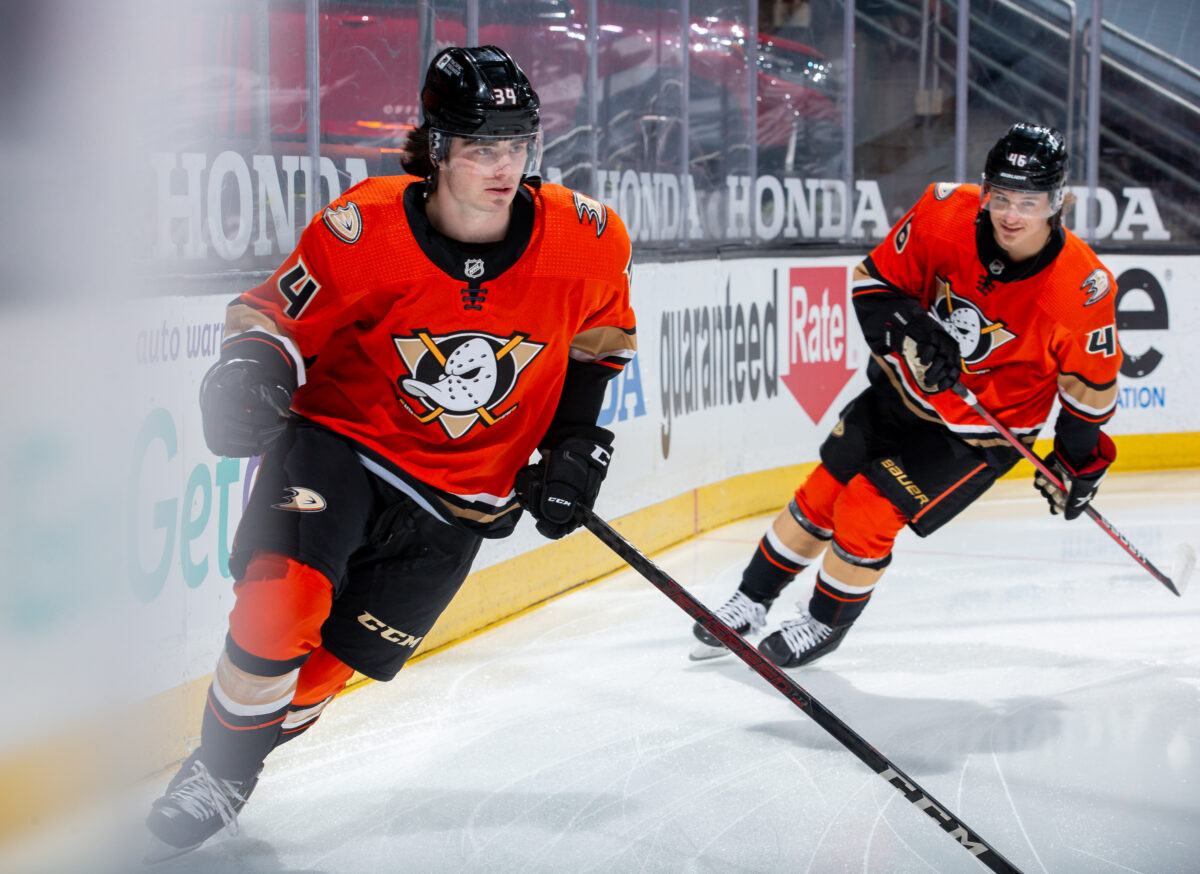
Drysdale’s numbers reflect a player who can flip the switch on offense in a flash but still has a lot to work on in the defensive zone. Part of this can be attributed to playing alongside Manson, whose mentorship to the young d-man cannot shroud his own poor performances this season (from, ‘Ducks’ Josh Manson and Jamie Drysdale pairing benefits everyone’, Orange County Register, 04/16/21).
I would like to see Drysdale next to Lindholm next season, to start. Their play styles complement each other well and having more than one regular left-right pairing will allow for a bit more flexibility.
Grade: C
Jacob Larsson
2019-20 Season: 2 G, 9 A, 11 P in 60 GP
2020-21 Season: 1 G, 6 A, 7 P in 46 GP
Analysis: Larsson’s NHL career to this point has not been glorious by any means. The Swede’s development seems to have plateaued and while there have been glimmers of improvement, it’s simply not good enough for someone that was drafted around roughly the same pick as current Vegas Golden Knight and former Duck Shea Theodore.
The two are clearly different players, that was obvious enough even before Theodore’s departure to Vegas, but Larsson has been given much more of a leash than Theodore was ever given during his time in Anaheim. Of course, a lot of that had to do with the man at the helm at the time, Randy Carlyle, whose no-nonsense style of play, which relies more on a man-to-man style of defense and an emphasis on physicality, meant that Theodore looked like a lost puppy with no bone to play with.
A purely speculative thought would be that general manager Bob Murray did not want to make the same mistake twice with Larsson as he did Theodore, which is why the former has stuck around for so long.
The Ducks also haven’t been hesitant to ship out former first-rounders that haven’t exactly planned out. They did so with Nick Ritchie, Kyle Palmieri and Emerson Etem in the past. All three had played a similar amount of games with the Ducks before departing. Seventh-round gem Ondrej Kase also departed after playing a similar amount of games as the trio, so for Larsson to be extended a contract offer last offseason—especially with the glut of defensemen that the Ducks had at their disposal—was a puzzling decision.
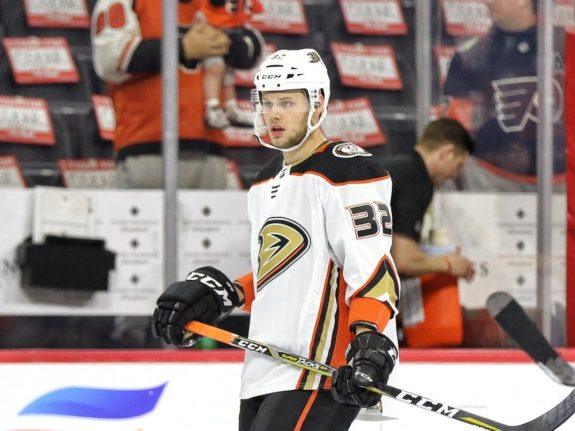
Larsson ended the season on a high note, collecting three points along with a plus-6 rating. This isn’t the type of player Ducks fans saw for most of the season, however, and it’s a bit deflating to see this kind of performance at a point in the season where the only objective to play for was a better performance chance at a higher draft pick.
It is worth noting, though, that 60 percent of Larsson’s zone starts were in the defensive zone. Whether that was by design or simply bad luck due to icings or similar occurrences is unknown, but it shows that head coach Dallas Eakins wasn’t afraid to put Larsson out there when he needed a strong defensive effort.
If Larsson can maintain this level of play next season, he has a good shot at being a solid backend option on the Ducks’ blue line. But there are plenty of options in San Diego waiting for the opportunity to arise, so Larsson will need to keep looking over his shoulder.
Grade: D
Josh Mahura
2019-20 Season: 1 G, 3 A, 4 P in 11 GP
2020-21 Season: 1 G, 3 A, 4 P in 13 GP
Analysis: Look too quickly and you might think someone accidentally copied and pasted Mahura’s 2019-20 season stats into the 2020-21 column. He spent more time in the AHL this season than he probably would have preferred, but the 23-year-old still managed to get in 13 games with the Ducks before the season’s conclusion.
It’s been difficult for him to find consistent playing time at the top level with the ever-rotating blue line pieces. In seasons past, he was blocked by players like Theodore, Larsson, Sami Vatanen and Brandon Montour. Even players who spent minimal time with the Ducks at the NHL level like Marcus Pettersson surpassed Mahura quickly.
Offense has never been a problem for Mahura, who has been a consistent contributor at the AHL level. His defensive work has been a bit lacking, as he found himself facing some of the same issues that have constantly plagued Larsson.
No matter what caliber of player you are, the difference in physicality and speed between the AHL and NHL is a different beast. Mahura hasn’t really been able to gauge that consistently yet. Whether it’s because he hasn’t received regular playing time at the top level is up for debate, but the former Red Deer Rebel has been caught out on many occasions while playing in the NHL.
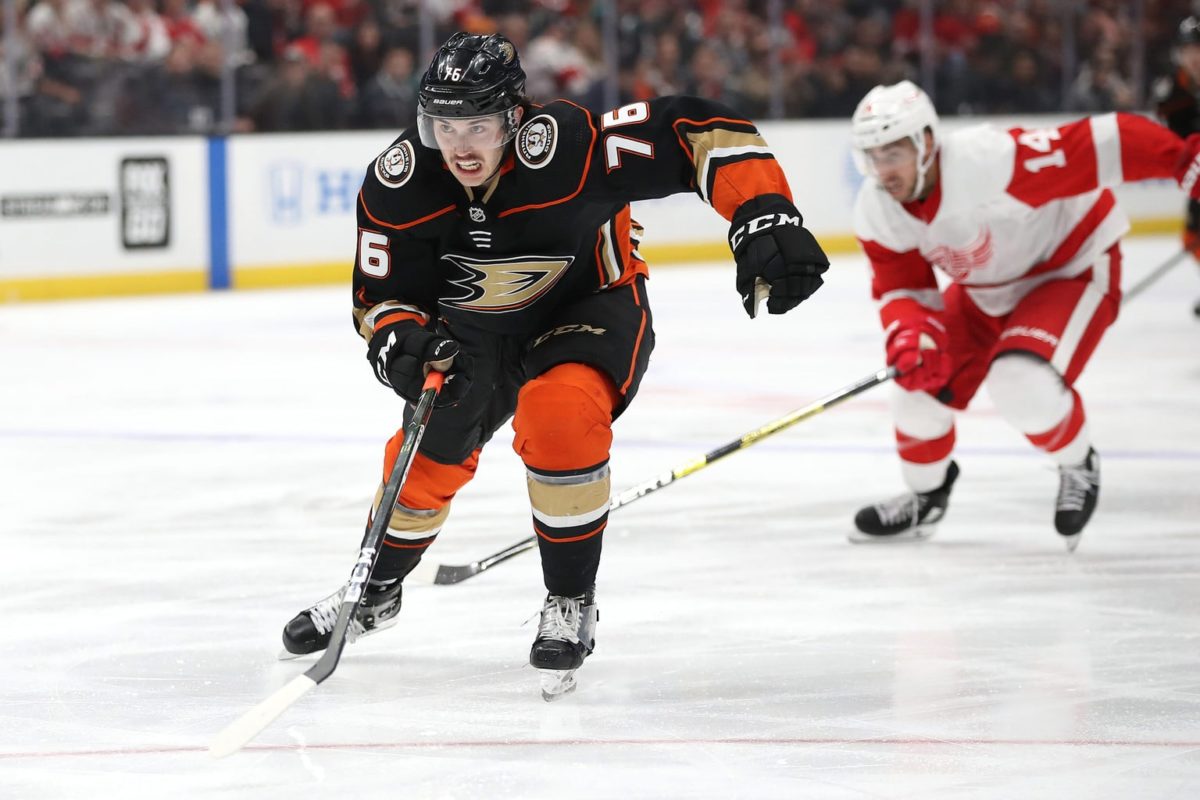
Before this season, I wrote about how it would be a make-or-break season for Mahura. He hasn’t really taken the step forward that the Ducks’ front office would like to see out of one of their defensemen.
Given the current status of the Ducks’ blue line, Mahura would be on the outside looking in after the Top-6 of Fowler, Manson, Lindholm, Drysdale, Fleury and Shattenkirk. That could change if one of Manson or Shattenkirk departs either via trade or expansion draft, but currently, there is no everyday spot in the lineup for Mahura. He’ll need to have a big training camp next season to have a shot at cracking the opening night roster.
Grade: C
Andy Welinski
2019-20 Season: 8 G, 13 A, 21 P in 42 GP (AHL)
2020-21 Season: 0 G, 0 A, 0 P in 13 GP
Welinski returned to the team who drafted him after spending last season with the Philadelphia Flyers AHL affiliate, the Lehigh Valley Phantoms. It was a bit of a weird season for Welinski—as it was for many players on the fringe of NHL rosters. He spent quite a bit of time on the taxi squad and didn’t play very often for the Ducks’ AHL team, the San Diego Gulls, even though they relocated to nearby Irvine for this AHL season.
The blueliner was neither good nor bad during the 13 games he appeared in for the Ducks. He even got a bit of time on the second power-play at one point when the Ducks were especially hurting due to injuries. Welinski is an unrestricted free agent this summer and it’s unlikely that he’ll be brought back unless Murray feels that the Gulls lack defensive depth.
Grade: C
Ben Hutton
2019-20 Season: 4 G, 12 A, 16 P in 65 GP
2020-21 Season: 1 G, 4 A, 5 P in 34 GP for Anaheim
Analysis: Hutton made the most out of his time with the Ducks. The then 27-year-old signed a player tryout with the Ducks during training camp and turned that into a one-year NHL deal. He likely signed the deal with the thought that he would be the seventh defenseman, someone who would fill in every so often but spend more time in the press box when everyone was healthy.
Of course, not everyone was healthy, as we all soon saw, which meant that Hutton became more of an everyday player, playing on the third defensive pair.
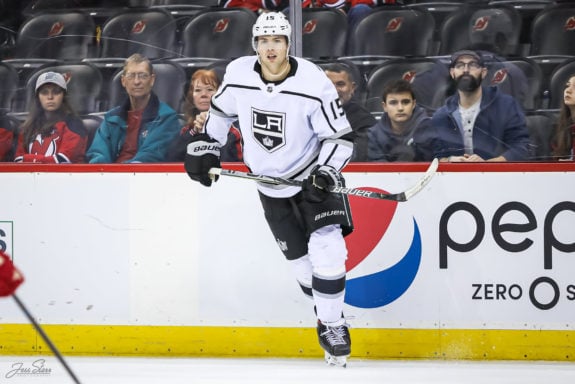
For as bad as Hutton’s numbers were with the Ducks, particularly his plus-minus of minus-13, he was still a serviceable player during his time in Anaheim and the Ducks got as much as you can ask out of a player who initially joined the team via a PTO.
In fact, the Ducks extracted so much value out of Hutton that they were able to collect a 2022 fifth-round pick from the Toronto Maple Leafs at the trade deadline for the 28-year-old. Now, Hutton is back in a familiar role as a depth defenseman and has only played four games for the Leafs since being acquired by them.
Grade: C
Jani Hakanpaa
2019-20 Season: 1 G, 0 A, 1 P in 5 GP
2020-21 Season: 0 G, 1 A, 1 P in 42 GP for Anaheim
Analysis: Hakanpaa got a cup of coffee with the Ducks last season shortly before the shutdown. He appeared in five games, registered a plus-1 and even scored his first career NHL goal—against the team that drafted him in the St. Louis Blues, to boot.
Once Christian Djoos was claimed off of waivers by the Detroit Red Wings during this past season’s training camp, it became more apparent that there was a regular spot on the blue line for Hakanpaa. The Finn was paired with Fowler to begin the season and the two were almost inseparable until the trade deadline when Hakanpaa was dealt in exchange for Fleury.
Latest Ducks Content:
- Ducks’ 2024-25 Bounce Back Candidates: Trevor Zegras
- Red Wings Should Still Pursue John Gibson Trade
- Anaheim Ducks Logo History
- Ducks News & Rumors: LaCombe, Vatrano, Sennecke & More
- Top Contenders for 2025 Calder Trophy
Hakanpaa isn’t the flashiest player by any means, but he knew his role and did it fairly well. His size and surreptitious speed meant that he could pinch at the right times while covering as much area as possible. He was the perfect complement to Fowler, who could roam a bit more freely, knowing that he had someone covering behind him at the blue line.
Hakanpaa is a player that I’m sure most fans wanted the team to keep around for a few more seasons, but the bottom line is that the Ducks got back a much more well-rounded and younger defenseman in Fleury.
This deal worked out for both teams as the Hurricanes were looking to add a bit more physicality to their blue line and had no room for Fleury while the Ducks are on the precipice of a rebuild and could do with another young puck mover on the backend.
Grade: B
It was by no means a spectacular season for the Ducks, let alone their blue line. But next season should see a fully healthy defensive core back at their best and while the team as a whole is still trying to figure things out, the defense should at least be back to being a strength of theirs.